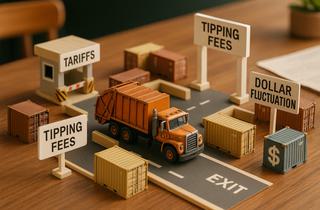Tariffs, tipping fees and a shaky loonie: How to keep your 2026 waste budget in check
August 5, 2025
Running a business in Ontario or Quebec already means juggling wages, rent and energy. Over the next eighteen months you will also feel three quieter cost pressures hiding inside every garbage or recycling invoice: a new 25% tariff on U.S. equipment, scheduled hikes to landfill tipping fees on both sides of the border and a Canadian dollar that still refuses to settle down. Understanding how each factor bites and acting sooner than your competitors can keep next year’s waste costs from chewing through cash you would rather invest elsewhere.

1. The 25% “Made in America” surcharge
Since March 4th 2025 any dumpster, compactor, baler part or truck component that crosses the border from the United States attracts a federal surtax of 25%. Ottawa applied the duty to roughly $30 billion in imports after Washington re-imposed steel and aluminum barriers (Department of Finance). The tariff schedule covers metal containers, machinery and vehicle parts, all commonly used in waste equipment.
For scale, a compactor that cost $20,000 in 2024 now invoices at $25,000 once the surtax lands. A replacement hydraulic cylinder once billed at $5,000 now runs $6,250. If your hauler still sources from U.S. suppliers, the difference shows up in lease rates and capital-cost recovery fees.
What you can do now
- Check whether a Canadian-built alternative meets spec. Even at a slightly higher sticker, skipping the surtax can keep total project costs in line.
- Audit your 2026 capital list. Flag anything that must ship from the United States and pencil in an extra 25% before you are surprised later.
- Stretch the life of existing assets with preventive maintenance. Spending a few hundred on hinge kits or seals this autumn beats buying a fully taxed bin in January.
2. Landfill tipping fees are climbing everywhere
Ontario
Municipal landfills continue edging gate rates up 3 to 5% a year. North Bay’s fee on general waste rose from $110 per tonne in 2024 to $115 in March 2025 and is approved to hit $118 on January 1st 2026 (BayToday). Sites with less remaining capacity such as Toronto’s Green Lane already charge well above $150 per tonne and rarely cut rates.
Quebec
Quebec’s provincial redevance landfill tax automatically rises by $2 every January. It sat at $32 per tonne in 2024, climbed to $34 in 2025 and is locked in for $36 come 2026 (Ministère de l’Environnement). Add local host-site fees and a commercial load near Montréal can easily top $100 per tonne before haulage.
Michigan and other U.S. export sites
Ontario brokers have long hauled garbage to Michigan thanks to a token state tip fee of US$0.36 per ton. That discount is fading: Governor Whitmer’s 2026 budget proposes US$5, aligning Michigan with Ohio and Indiana (Waste Today). Even after the hike Michigan remains cheaper than Ontario, but currency conversion erodes much of the gap.
What you can do now
- Measure your true landfill tonnage, then tally how each extra dollar per tonne ripples through next year’s budget.
- Advance any recycling or composting change that knocks weight out of the landfill stream. Every diverted tonne saves the full tipping fee.
- If you export to Michigan, ask your broker for a what-if bill at US$5 per ton and a 1.30 exchange rate. Better to see that number now.
3. The loonie could shift under your feet
Plenty of waste costs, including equipment and some landfill or fuel surcharges, price in U.S. dollars. A weaker loonie inflates them, a stronger one provides relief. Scotiabank’s June 2025 forecast pegs CAD-USD at 1.34 by year-end 2025 and 1.28 by 2026, stronger than the 1.44 seen in late 2024 (Scotiabank Forecast Snapshot). Forecasts miss, so build in a buffer.
What you can do now
- Price crucial U.S. purchases twice - once at 1.28 and again at a stress case of 1.35. Budget for the worst and rejoice if the better rate arrives.
- Clarify with vendors how exchange swings trigger price adjustments in long-term service contracts.
- Double-check any fuel-surcharge clauses tied to U.S. benchmarks since forex shifts hide there too.
Putting it all together
All three cost drivers, tariffs, published tipping-fee schedules and forex volatility, are public knowledge. The businesses that keep waste expenses steady will be those acting in 2024 and 2025, not scrambling once invoices spike in 2026.
- Map your exposure. Pull a year of invoices and flag every line touched by tariffs, fee hikes or U.S. pricing.
- Remove needless tonnes. Cardboard balers, organics bins and better sorting pay themselves off faster with each new fee hike.
- Negotiate early. Haulers see the same fee tables you do. Securing multi-year terms now can lock today’s rate or at least cap tomorrow’s.
- Time equipment buys. If U.S. parts are unavoidable, order ahead of further tariff moves or currency swings, and lean on Canadian options whenever possible.
Need a second set of eyes? A quick, no-cost review with a trusted waste-management advisor can keep your 2026 budget on track before the new charges land.
Let's build a greener future together
Reach out today for a free consultation customized for your unique business needs.
